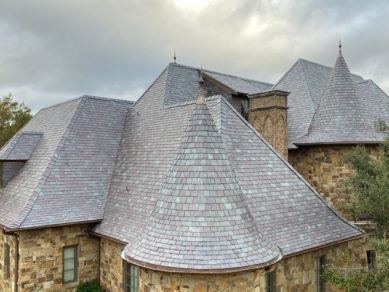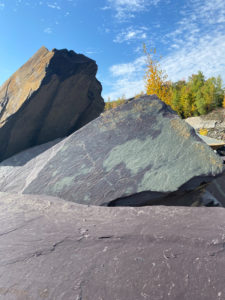
Our desire to live more sustainably on the planet has resulted in numerous trends from carbon reduction and renewable resources to using natural products and local sourcing.

Slate is natural, and its use as a building product, such as slate roof shingles and slate exterior wall cladding, is in line with these trends.
1. Locally sourced
The largest slate mines are in Spain, Brazil, and China. However, there are plenty of slate mines located in North America, so there are numerous, local, quality slate options.
Sourcing building materials locally decreases the carbon footprint of the product. Slate supplier North Country Slate is located in the Greater Toronto area, which is a large market and provides access to Canada’s largest international transportation hub.
2. Processed in a non-destructive manner
A lot of manufactured products require the use of chemicals or other substances that need to be disposed in a particular way, because they’re harmful to the environment.
This applies to the non-natural shingle products as well. Asphalt shingles use asphalt—a petroleum product—sealant, and laminant, all of which take a long time to break down and have negative effects on environmental health.
The processing of slate for slate shingles doesn’t require chemicals. And it is processed where it’s quarried. Highly skilled quarry workers and sawyers cut the stone to the desired size and shape.
3. Waste reduction
Waste can be created either as the result of creating a product, of installing a product, or when disposing of a product at the end of its lifespan.
Other environmental benefits of slate roofs include waste reduction. A slate building product doesn’t produce waste at any point in its life cycle, because it’s a natural product. Waste and overburden can be used around the quarry for roads and left on site (where it was found). See slate sizes.
During installation of a slate roof, experienced slate contractors will ensure that all slate shingles are resourcefully used on the roof. And at the end of their 100+ year lifespan, slate shingles, can be repurposed into landscaping stone, construction aggregate, clean fill, and artistic materials.
Asphalt roofs, on the other hand, go to the landfill at the end of their lifecycle, which is 15 to 30 years. Nearly 5.0% of annual landfill intake in North America is roofing waste. Whereas a slate roof can last 100+ years and be returned to the earth, because it came from the earth.
4. A low carbon footprint
Slate has the lowest embodied carbon value of all the roofing materials—about 16% (at most) compared to other roofing materials.
A slate roof is a great insulator. It can also help lower building heating and cooling costs. According to the National Slate Association, slate roofs add to a structure’s temperature stability and can help lower net energy costs. This lowers the carbon footprint of the building.
5. Use natural products
We already mentioned slate is 100% natural. It’s stone—naturally formed.
When slate is used as a roofing product or other building material, it’s both sustainable and environmentally friendly. If we embrace slate as an environmental building product, we can live more sustainably, produce less waste, and decrease our carbon footprint.
Learn what other benefits slate provides.
From local sourcing that minimizes carbon footprints to its non-destructive processing, waste-reduction properties, and remarkably low carbon footprint, slate stands as a testament to our ability to integrate natural products into our built environment. By for roofing and building projects, we not only contribute to waste reduction but also harnesses inherent beauty and durability. Contact North Country Slate today for design advice and quotes on slate tiles for your next roofing project.